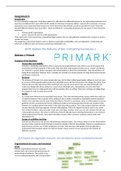Essay
DISTINCTION Essay Unit 1- exploring business, assignment 1 Learning aim A and B.
- Module
- Unit 1- exploring business
- Institution
- PEARSON (PEARSON)
This is a distinction example of unit 1- exploring business assignment 1 essay. To compare a profit and not for profit organisation. In this report I have used primark and cancer research. This includes Learning aim A and B.
[Show more]



